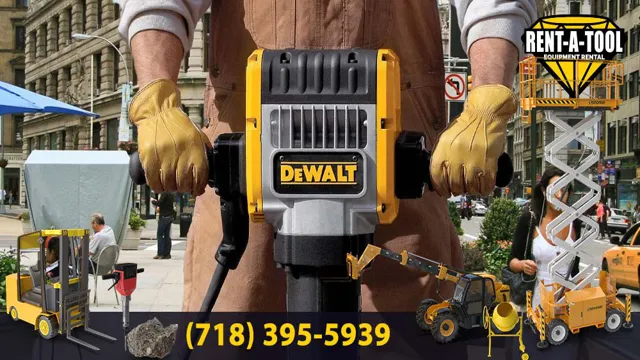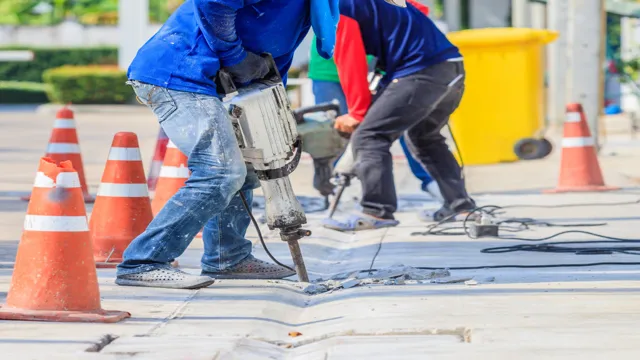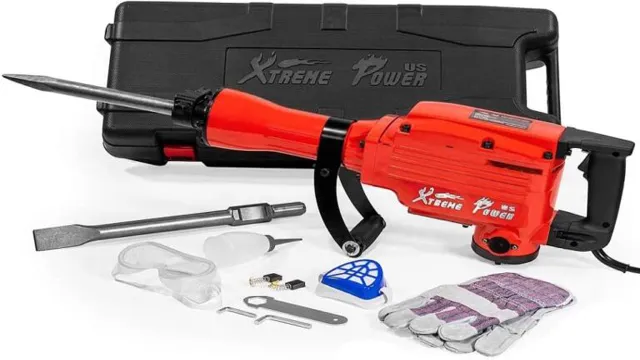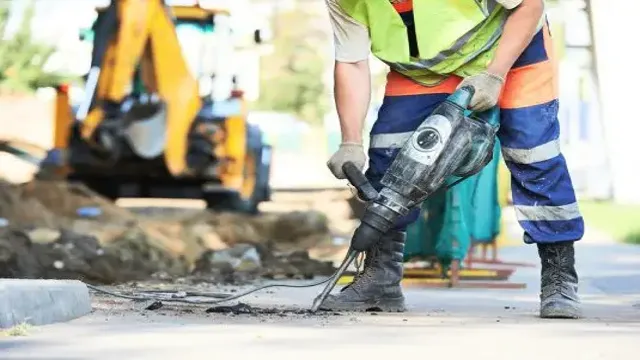How Do You Use a Jackhammer? A Comprehensive Guide for Novice Users
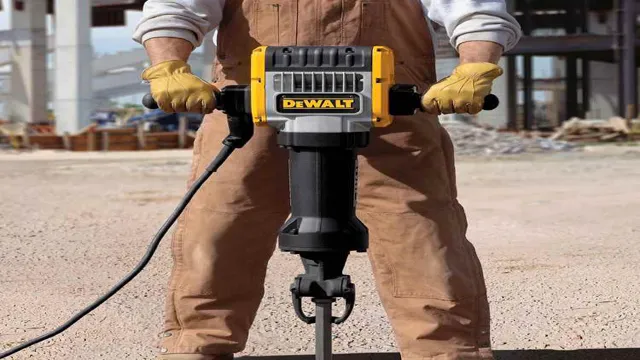
Has that stubborn concrete slab in your yard given you a headache? Are you tired of trying to break it down using just a sledgehammer? It’s time to upgrade to a jackhammer! Jackhammers are powerful machines that can make short work of concrete, stone and other tough materials. But don’t be intimidated by their size and speed – with the right technique and safety precautions, using a jackhammer can be a breeze. In this step-by-step guide, we’ll take you through the process of using a jackhammer, from choosing the right tool for your project, to operating it safely and efficiently.
So put on your safety gear and get ready to make some noise – let’s get started!
Preparation
Using a jackhammer can be a daunting task, but with the right preparation, it can be done safely and efficiently. First, ensure that you have the appropriate personal protective equipment, such as ear protection, eye protection, and gloves. Next, assess the area in which you will be operating the jackhammer and remove any obstacles or hazards.
It’s important to have a clear workspace, free of any potential safety risks. Before starting the jackhammer, check the tool’s oil and fuel levels and make sure it is in good working condition. Then, hold the jackhammer firmly with both hands and begin working in a consistent and controlled motion.
It’s important to take breaks and stretch periodically to avoid injury and fatigue. Remember to never forcefully push or lift the jackhammer as it can lead to injury or damage to the tool. With proper preparation and technique, using a jackhammer can be a successful and productive endeavor.
Choose the right jackhammer for the task
As with any construction tool, it’s important to choose the right jackhammer for the task at hand. Before you start breaking up concrete, make sure to assess the size of the job and the necessary power of the tool. Consider the weight and size of the jackhammer, as well as its impact force.
A smaller jackhammer may be sufficient for smaller jobs, like removing tiles or bricks, while a larger model may be necessary for breaking up thick slabs of concrete. Preparation is also key when using a jackhammer. Make sure to wear proper safety gear, including eye and ear protection, as well as gloves and sturdy, non-slip shoes.
It’s also important to clear the work area of any obstacles or debris that could cause tripping or falling hazards. Mark out the area where you’ll be working and make sure it’s well-ventilated to prevent inhalation of any dust or fumes that may be created during the job. Overall, choosing the right jackhammer and adequately preparing for the job can make all the difference in its outcome.
Take the time to assess the job, gather the necessary safety equipment, and clear your work area before beginning. By doing so, you’ll ensure a safer and more efficient experience.

Ensure all safety equipment is worn
As you prepare for any potentially hazardous activity, safety must be a top priority. One of the best ways to ensure your safety is by wearing protective gear and equipment at all times. Regardless of how familiar you might be with the activity, there is always some level of risk that demands that you take safety precautions seriously.
You should ensure that all safety equipment is worn, from hard hats, gloves, safety glasses, to earplugs and more, depending on the nature of the activity. The main keyword “safety equipment” should be at the center of all your preparations. You should inspect your gear beforehand and make sure that it is in good condition and fits correctly.
You can also consult with experts in the relevant field to ascertain the specific gear and equipment needed for the activity. Ultimately, taking proper safety precautions can make the difference between enjoying the activity and landing in the ER injured. So, always ensure that safety equipment is worn to protect yourself adequately.
Using the Jackhammer
If you’ve ever wondered how to use a jackhammer, it can seem intimidating at first. But with the right technique, it can be a useful tool for breaking up concrete or asphalt. First, make sure you have all the necessary safety gear, including eye protection, earplugs, a hard hat, and steel-toed boots.
Next, position the jackhammer at a 45-degree angle to the surface you’re breaking up, with the bit against the area you want to demolish. Begin with short bursts of the trigger, allowing the chisel bit to do the work for you. Avoid applying too much force or pushing down too hard, as this can cause unnecessary strain on your arms and back.
As you work your way across the surface, keep the jackhammer moving in a back-and-forth motion to create a clean break. With practice and patience, you’ll soon learn how to use a jackhammer like a pro and tackle any demolition project with confidence.
Position the jackhammer correctly
When it comes to using a jackhammer, one of the most important things you need to know is how to position it correctly. This will not only help you be more efficient with the tool, but it will also keep you safe while using it. First and foremost, make sure the area you’ll be using the jackhammer on is clear of any debris or obstructions.
This will give you a better view of the surface, allowing you to spot any potential hazards that could cause the jackhammer to bounce or slip. Next, ensure that you have a good grip on the tool, with both hands firmly on the handles. You should also stand with your feet shoulder-width apart to maintain your balance.
Once you’re in position, angle the jackhammer correctly, with the point facing down at a slight angle towards the surface you’ll be breaking up. This will ensure that you’re hitting the surface at an optimal angle, allowing you to efficiently break it up without putting excessive strain on the tool. By following these simple steps, you’ll be able to use the jackhammer safely and effectively, making your job easier and ensuring that you get the best possible results.
Start the jackhammer
If you need to break concrete or other hard surfaces, a jackhammer can be a helpful tool. But before you start the jackhammer, make sure you have the proper safety gear, including safety glasses, earplugs or earmuffs, and sturdy work gloves. Once you’re ready to begin, make sure the jackhammer is properly secured and adjusted for the task at hand.
Start the jackhammer slowly and steadily, using the weight of the tool to do the work for you. Be sure to maintain a firm grip on the tool, but don’t use too much force, which could cause the jackhammer to bounce uncontrollably and potentially injure you. Keep the tool on a vertical plane as much as possible to avoid damaging nearby structures or surfaces.
With a little practice and patience, you can use a jackhammer safely and effectively to complete a variety of demolition and construction tasks.
Apply pressure to the jackhammer
Using a jackhammer can be a challenging and tiring job, but with a few tips, it can become more manageable. To start, when operating a jackhammer, always ensure the surface is stable and flat. This will promote safety and make your work faster and easier.
When using the machine, always keep a firm grip on the handle to maintain control as it can generate a strong vibration. Then, position the jackhammer at a 45-degree angle to the surface and apply pressure to the machine. Applying pressure will help the jackhammer chip away at the surface faster.
Remember, don’t force the machine too much as it can cause the tool to break down frequently, and never attempt to use the jackhammer under wet conditions. Applying these safety measures and tips will go a long way in promoting successful and incident-free use of the jackhammer.
Maintaining the Jackhammer
If you’ve ever wondered how to use a jackhammer, you’re in luck! These powerful tools can make tough construction and demolition jobs a breeze. However, it’s important to know how to maintain the jackhammer to keep it working at its best. First, make sure to always use the proper lubricant to keep the moving parts of the jackhammer functioning smoothly.
Additionally, check the air filter regularly and replace it as needed to ensure the engine is running at peak efficiency. Always store the jackhammer in a cool, dry place to avoid any damage when not in use. Finally, make sure to inspect the jackhammer often for any signs of wear and tear and replace any worn or damaged parts promptly.
By following these simple maintenance steps, you can keep your jackhammer running smoothly for years to come.
Clean the jackhammer regularly
Maintaining your jackhammer is crucial if you want to keep it working optimally. One of the most important aspects of maintaining your jackhammer is cleaning it regularly. Over time, dust and debris can build up inside the tool and cause it to malfunction.
Regular cleaning can help to remove this debris and keep your jackhammer running smoothly. There are a few steps you can take to clean your jackhammer effectively. First, make sure you unplug it from any power source before starting.
Use a brush to remove any loose dirt and debris from the exterior. Next, disassemble the tool and use compressed air to blow out any remaining debris from the inside. After cleaning, inspect your jackhammer for any damaged or worn-out parts.
If you notice any problems, it’s important to replace these parts to ensure safe and effective use of the tool. Regular maintenance, including cleaning, can help extend the life of your jackhammer and save you money in the long run. Remember to store your jackhammer in a dry, cool place to prevent corrosion and damage.
By taking these simple steps, you can keep your jackhammer running smoothly and avoid costly repairs. So, don’t forget to clean your jackhammer regularly and enjoy its optimal performance.
Keep the jackhammer lubricated
To ensure that your jackhammer is performing at its best, it is crucial to keep it lubricated. This can help to reduce friction between the moving parts, which can extend the life of the tool and prevent unnecessary wear and tear. There are a few things to keep in mind when it comes to maintaining your jackhammer’s lubrication.
First and foremost, always use the manufacturer’s recommended oil or grease. In addition, make sure that you are using the right amount of lubricant and that you are applying it in the right places. Too much lubrication can be just as bad as too little, and applying it in the wrong spots can lead to performance issues.
Finally, don’t forget to clean and inspect your jackhammer regularly. By doing so, you can catch any potential issues early on and avoid having to deal with bigger problems down the line. Keyword: Jackhammer lubrication
Conclusion
When it comes to using a jackhammer, the key is to let the machine do the heavy lifting while you guide it in the right direction. It’s sort of like dancing with a power tool; you need to keep your balance, move with the beat, and stay focused on the end goal. Just remember that a jackhammer may be loud and powerful, but with the right technique, you can chip away at any obstacle in your way.
So grab your earplugs, hold on tight, and get ready to break through to the other side!”
FAQs
What is a jackhammer and how does it work?
A jackhammer is a power tool that uses compressed air or electricity to drive a hammering mechanism to break hard surfaces such as concrete, asphalt, and rock. The hammering mechanism repeatedly strikes a chisel or point to break the material apart.
What safety precautions should you take when using a jackhammer?
It is important to wear appropriate personal protective equipment such as earplugs, safety glasses, and a hardhat. Always make sure the jackhammer is properly maintained and inspected before use. Avoid using the jackhammer in wet or slippery conditions, and keep bystanders at a safe distance.
What is the proper technique for using a jackhammer?
The operator should firmly grip the jackhammer with both hands, keeping the elbows close to the body. The chisel or point should be held at a 45-degree angle to the surface being broken, and the operator should use a steady back and forth motion to break up the material. It is important to avoid putting excessive pressure on the jackhammer, as this can damage the tool.
How do you choose the right size jackhammer for a job?
The size of the jackhammer needed for a job depends on the thickness and hardness of the material to be broken. Generally, larger jackhammers are used for thicker or harder materials, while smaller jackhammers are used for lighter or softer materials. It is important to choose the right size jackhammer to avoid damaging the tool or taking longer than necessary to complete the job.
How do you maintain a jackhammer?
Regular maintenance is important to keep a jackhammer in good condition. This includes checking the oil and air filters, greasing the moving parts, and inspecting the hoses and fittings for damage. The jackhammer should also be cleaned after each use to remove dirt and debris that can cause wear and tear.
Can a jackhammer be used for tasks other than breaking concrete?
Yes, a jackhammer can be used for a variety of tasks such as digging, chipping away at tile or mortar, or even breaking up tree roots in the soil. However, it is important to use the appropriate chisel or point for the task at hand.
What is the maximum depth a jackhammer can break through concrete?
The maximum depth a jackhammer can break through concrete depends on the type of concrete and the size of the jackhammer being used. Generally, a handheld jackhammer can break through concrete up to 4 inches thick, while larger jackhammers mounted on excavators or other machinery can break through thicker concrete.

